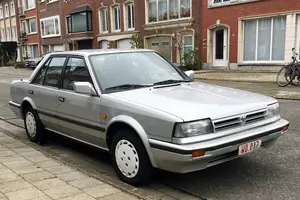


| Vehicle | Curb weight | Difference from world's smallest | Weight to power ratio | 0—60 mph acceleration ratio | Consumption ratio |
|---|---|---|---|---|---|
| 1.5i |
1160 kg / 2558 lbs |
735 kg (1621 lbs) heavier | 11 kg to 1 hp | 104 kg/s (229 lbs/s) |
155 kg/L (342 lbs/L) |
| 2.0i |
1230 kg / 2712 lbs |
805 kg (1775 lbs) heavier | 9 kg to 1 hp | 121 kg/s (267 lbs/s) |
128 kg/L (282 lbs/L) |
| Vehicle | 1.5i |
|---|---|
| Curb weight |
1160 kg / 2558 lbs |
| Difference from world's smallest | 735 kg (735 lbs) heavier |
| Weight to power ratio | 11 kg to 1 hp |
| 0—60 mph acceleration ratio | 104 kg/s (229 lbs/s) |
| Consumption ratio |
155 kg/L (342 lbs/L) |
| Vehicle | 2.0i |
| Curb weight |
1230 kg / 2712 lbs |
| Difference from world's smallest | 805 kg (805 lbs) heavier |
| Weight to power ratio | 9 kg to 1 hp |
| 0—60 mph acceleration ratio | 121 kg/s (267 lbs/s) |
| Consumption ratio |
128 kg/L (282 lbs/L) |

| Vehicle | Curb weight | Difference from world's smallest | Weight to power ratio | 0—60 mph acceleration ratio | Consumption ratio |
|---|---|---|---|---|---|
| 1.8i |
1270 kg / 2800 lbs |
845 kg (1863 lbs) heavier | 11 kg to 1 hp | 109 kg/s (240 lbs/s) |
144 kg/L (318 lbs/L) |
| 1.5i |
1130 kg / 2492 lbs |
705 kg (1555 lbs) heavier | 11 kg to 1 hp | 92 kg/s (203 lbs/s) |
151 kg/L (333 lbs/L) |
| Vehicle | 1.8i |
|---|---|
| Curb weight |
1270 kg / 2800 lbs |
| Difference from world's smallest | 845 kg (845 lbs) heavier |
| Weight to power ratio | 11 kg to 1 hp |
| 0—60 mph acceleration ratio | 109 kg/s (240 lbs/s) |
| Consumption ratio |
144 kg/L (318 lbs/L) |
| Vehicle | 1.5i |
| Curb weight |
1130 kg / 2492 lbs |
| Difference from world's smallest | 705 kg (705 lbs) heavier |
| Weight to power ratio | 11 kg to 1 hp |
| 0—60 mph acceleration ratio | 92 kg/s (203 lbs/s) |
| Consumption ratio |
151 kg/L (333 lbs/L) |

| Vehicle | Curb weight | Difference from world's smallest | Weight to power ratio | 0—60 mph acceleration ratio | Consumption ratio |
|---|---|---|---|---|---|
| 1.8 XE Attesa |
1320 kg / 2911 lbs |
895 kg (1974 lbs) heavier | 11 kg to 1 hp | 106 kg/s (234 lbs/s) |
142 kg/L (313 lbs/L) |
| 2.0d |
1220 kg / 2690 lbs |
795 kg (1753 lbs) heavier | 16 kg to 1 hp | 79 kg/s (174 lbs/s) |
172 kg/L (379 lbs/L) |
| 1.8 Le grand |
1190 kg / 2624 lbs |
765 kg (1687 lbs) heavier | 10 kg to 1 hp | 109 kg/s (240 lbs/s) |
135 kg/L (298 lbs/L) |
| 2.0 SSS-Z |
1250 kg / 2756 lbs |
825 kg (1819 lbs) heavier | 7 kg to 1 hp | 169 kg/s (373 lbs/s) |
111 kg/L (245 lbs/L) |
| 2.0i |
1200 kg / 2646 lbs |
775 kg (1709 lbs) heavier | 8 kg to 1 hp | 125 kg/s (276 lbs/s) |
128 kg/L (282 lbs/L) |
| 1.8 Eprise |
1170 kg / 2580 lbs |
745 kg (1643 lbs) heavier | 9 kg to 1 hp | 115 kg/s (254 lbs/s) |
141 kg/L (311 lbs/L) |
| 2.0 SSS |
1320 kg / 2911 lbs |
895 kg (1974 lbs) heavier | 9 kg to 1 hp | 138 kg/s (304 lbs/s) |
128 kg/L (282 lbs/L) |
| 1.8 FE |
1180 kg / 2602 lbs |
755 kg (1665 lbs) heavier | 9 kg to 1 hp | 109 kg/s (240 lbs/s) |
134 kg/L (295 lbs/L) |
| 2.0 SSS Limited |
1210 kg / 2668 lbs |
785 kg (1731 lbs) heavier | 8 kg to 1 hp | 132 kg/s (291 lbs/s) |
129 kg/L (284 lbs/L) |
| Vehicle | 1.8 XE Attesa |
|---|---|
| Curb weight |
1320 kg / 2911 lbs |
| Difference from world's smallest | 895 kg (895 lbs) heavier |
| Weight to power ratio | 11 kg to 1 hp |
| 0—60 mph acceleration ratio | 106 kg/s (234 lbs/s) |
| Consumption ratio |
142 kg/L (313 lbs/L) |
| Vehicle | 2.0d |
| Curb weight |
1220 kg / 2690 lbs |
| Difference from world's smallest | 795 kg (795 lbs) heavier |
| Weight to power ratio | 16 kg to 1 hp |
| 0—60 mph acceleration ratio | 79 kg/s (174 lbs/s) |
| Consumption ratio |
172 kg/L (379 lbs/L) |
| Vehicle | 1.8 Le grand |
| Curb weight |
1190 kg / 2624 lbs |
| Difference from world's smallest | 765 kg (765 lbs) heavier |
| Weight to power ratio | 10 kg to 1 hp |
| 0—60 mph acceleration ratio | 109 kg/s (240 lbs/s) |
| Consumption ratio |
135 kg/L (298 lbs/L) |
| Vehicle | 2.0 SSS-Z |
| Curb weight |
1250 kg / 2756 lbs |
| Difference from world's smallest | 825 kg (825 lbs) heavier |
| Weight to power ratio | 7 kg to 1 hp |
| 0—60 mph acceleration ratio | 169 kg/s (373 lbs/s) |
| Consumption ratio |
111 kg/L (245 lbs/L) |
| Vehicle | 2.0i |
| Curb weight |
1200 kg / 2646 lbs |
| Difference from world's smallest | 775 kg (775 lbs) heavier |
| Weight to power ratio | 8 kg to 1 hp |
| 0—60 mph acceleration ratio | 125 kg/s (276 lbs/s) |
| Consumption ratio |
128 kg/L (282 lbs/L) |
| Vehicle | 1.8 Eprise |
| Curb weight |
1170 kg / 2580 lbs |
| Difference from world's smallest | 745 kg (745 lbs) heavier |
| Weight to power ratio | 9 kg to 1 hp |
| 0—60 mph acceleration ratio | 115 kg/s (254 lbs/s) |
| Consumption ratio |
141 kg/L (311 lbs/L) |
| Vehicle | 2.0 SSS |
| Curb weight |
1320 kg / 2911 lbs |
| Difference from world's smallest | 895 kg (895 lbs) heavier |
| Weight to power ratio | 9 kg to 1 hp |
| 0—60 mph acceleration ratio | 138 kg/s (304 lbs/s) |
| Consumption ratio |
128 kg/L (282 lbs/L) |
| Vehicle | 1.8 FE |
| Curb weight |
1180 kg / 2602 lbs |
| Difference from world's smallest | 755 kg (755 lbs) heavier |
| Weight to power ratio | 9 kg to 1 hp |
| 0—60 mph acceleration ratio | 109 kg/s (240 lbs/s) |
| Consumption ratio |
134 kg/L (295 lbs/L) |
| Vehicle | 2.0 SSS Limited |
| Curb weight |
1210 kg / 2668 lbs |
| Difference from world's smallest | 785 kg (785 lbs) heavier |
| Weight to power ratio | 8 kg to 1 hp |
| 0—60 mph acceleration ratio | 132 kg/s (291 lbs/s) |
| Consumption ratio |
129 kg/L (284 lbs/L) |

| Vehicle | Curb weight | Difference from world's smallest | Weight to power ratio | 0—60 mph acceleration ratio | Consumption ratio |
|---|---|---|---|---|---|
| 2.0D |
1230 kg / 2712 lbs |
805 kg (1775 lbs) heavier | 16 kg to 1 hp | - | - |
| 2.0i |
1370 kg / 3021 lbs |
945 kg (2084 lbs) heavier | 9 kg to 1 hp | - | - |
| 2.4 |
1280 kg / 2822 lbs |
855 kg (1885 lbs) heavier | 9 kg to 1 hp | - | - |
| 1.8i |
1180 kg / 2602 lbs |
755 kg (1665 lbs) heavier | 9 kg to 1 hp | - | - |
| 2.0T |
1400 kg / 3087 lbs |
975 kg (2150 lbs) heavier | 7 kg to 1 hp | - | - |
| Vehicle | 2.0D |
|---|---|
| Curb weight |
1230 kg / 2712 lbs |
| Difference from world's smallest | 805 kg (805 lbs) heavier |
| Weight to power ratio | 16 kg to 1 hp |
| 0—60 mph acceleration ratio | - |
| Consumption ratio | - |
| Vehicle | 2.0i |
| Curb weight |
1370 kg / 3021 lbs |
| Difference from world's smallest | 945 kg (945 lbs) heavier |
| Weight to power ratio | 9 kg to 1 hp |
| 0—60 mph acceleration ratio | - |
| Consumption ratio | - |
| Vehicle | 2.4 |
| Curb weight |
1280 kg / 2822 lbs |
| Difference from world's smallest | 855 kg (855 lbs) heavier |
| Weight to power ratio | 9 kg to 1 hp |
| 0—60 mph acceleration ratio | - |
| Consumption ratio | - |
| Vehicle | 1.8i |
| Curb weight |
1180 kg / 2602 lbs |
| Difference from world's smallest | 755 kg (755 lbs) heavier |
| Weight to power ratio | 9 kg to 1 hp |
| 0—60 mph acceleration ratio | - |
| Consumption ratio | - |
| Vehicle | 2.0T |
| Curb weight |
1400 kg / 3087 lbs |
| Difference from world's smallest | 975 kg (975 lbs) heavier |
| Weight to power ratio | 7 kg to 1 hp |
| 0—60 mph acceleration ratio | - |
| Consumption ratio | - |